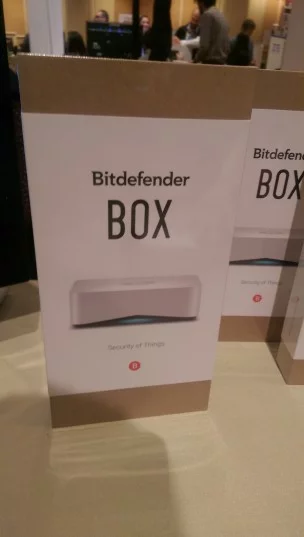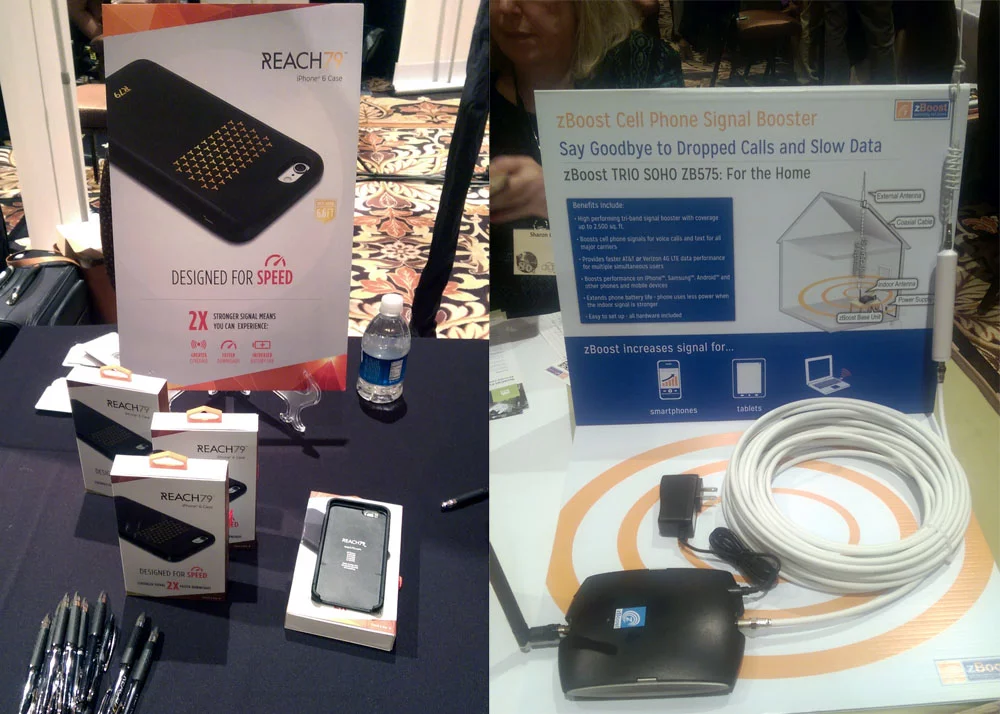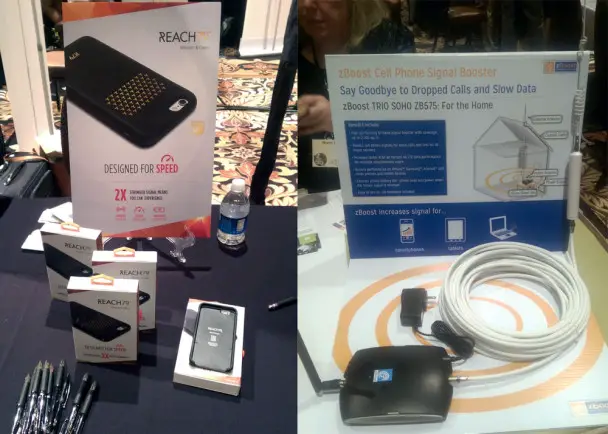Digesting CES – Part 2
 Making new tech work with old ideas
Making new tech work with old ideas
Your cell phone carrier can’t deliver what they promise, so you’ll just need to buy this antenna here. Multiple signal-boosting cases and powered antennas reared their ugly heads harkening back to the days of rabbit ears with tin foil wrapped around the poles.
There were two types heavily represented – the ones that work by providing a large surface underneath your case’s plastic that help to funnel the signal in allowing you to get better service while you’re on the go, and the unwieldy plug-ins that use 40 or so feet of cable antennae and a powered rebroadcaster to boost signals it hears.
The first of these is just plain antenna tech with better materials – the type your phone has about a quarter inch of inside of it expanded to a large patch, and the second comes with more wiring than you’d probably have with a landline. Both work, although how much depends on what types you get and exactly why your cell provider doesn’t work.
The case antennas I saw when positioned on my phone appeared to give me an extra bar. However, I didn’t have time to hold up the line to conduct speed tests on any of the ones I tried. The booster devices you’ll just have to check whether they work with your carrier or are complete bunk.
These have been around for a while now, but evidently it’s catching on that cell phone companies make money by lying to customers and getting them stuck on underperforming service.
Stop with the non-functioning antivirus already
 Something that’s been around in the corporate world for a while now is gaining traction in the consumer world: antivirus gateways. No longer do you devote resources to scanning applications and websites after they’re loaded, update virus definitions, then still get infected because the only virus that spreads these days is an undetectable virus made in the last few days.
Something that’s been around in the corporate world for a while now is gaining traction in the consumer world: antivirus gateways. No longer do you devote resources to scanning applications and websites after they’re loaded, update virus definitions, then still get infected because the only virus that spreads these days is an undetectable virus made in the last few days.
Companies like Bitdefender give you a box. You put it on your network. All your traffic gets scanned for exploits, viruses, Justin Bieber music, and any websites devoted to The Wire.
If you’re outside of your network and able to connect to your carrier’s data signal, you can VPN back through your network security box and be protected still without all of the overhead required to operate multiple antivirus solutions.
I didn’t have a chance to test this out, but I’d wonder how well it would protect someone who’s tunneling encrypted traffic over it ala TOR or similar.
The Bitdefender box is about $99 for the hardware, and $99 for the service for a year.
I believe I was told there’s no limits on the number of devices allowed to sit behind it, which means you can probably get your in-laws on a VPN to your house and stop having to remove viruses and malware from their computer when you go back for Christmas.
Bitdefender also gave me a flask of something they said was from Romania and 120 proof, so they’re good people.
Magnificent beaver totems
 While some companies at CES were aiming at the little lifestyle adaptations one has to make to live in a connected world, others were realizing your life would be better with a Justin Beaver.
While some companies at CES were aiming at the little lifestyle adaptations one has to make to live in a connected world, others were realizing your life would be better with a Justin Beaver.
There are few words to describe the significantly increased everything you’ll have with one of these. Sadly I was limited in what I could get back to Nashville, and even throwing my laptop and personal belongings away this was not going to fit.
I think the company also makes phone cases or something. I was too blown away by their main offering there was no going any further.
Moar teh NAS!!
As more and more methods of media copy protection are deployed you’d think the requirements for backed home network accessible storage would go down, but it’s not.
Network routers with RAID arrays are coming to your house at the prices for commercial network routers and small RAID arrays.
This is another corporate world IT thingie entering into the home world. Not a bad thing.
The main difference between a corporate NAS and the offerings I saw at CES are that the ones at CES do on the fly transcoding for you, so no more downloading an MKV only to find out you can’t play it on your XBOX 360 without putting it on a media server and running a transcoding app.
The entry level pricing into these things was pretty hefty, and you’re probably going to have to purchase hard drives for your RAID if you want to do something silly like store data safely in your house.
Things claiming to read your brainwaves
 Two years ago at CES was a device claiming to tell whether or not you were paying while driving. I tried to use it, no matter what I did the thing didn’t work. I was told that it must be the batteries and then the presenter waved me away and started another demo. It worked on the third or fourth person who tried it. I didn’t think much of this.
Two years ago at CES was a device claiming to tell whether or not you were paying while driving. I tried to use it, no matter what I did the thing didn’t work. I was told that it must be the batteries and then the presenter waved me away and started another demo. It worked on the third or fourth person who tried it. I didn’t think much of this.
This year there were all sorts of brainwave monitoring things. They also failed to provide a measurable return on anyone I could observe, and when I attempted one of them, completed the mental image training, etc. I completely won their game on try #1, try #2 failed to accomplish anything.
These were less than ideal circumstances, but with technology designed to monitor you in less than ideal circumstances it would be nice to know you could count on it to get the thing you just trained on it.
Other devices claimed to read your waves and guide you to focused, relaxed, whatever states. Once again, less than ideal circumstances and effects immeasurable in one short demo as people want these to be real.
It reminds me a bit of something Robert Anton Wilson wrote back about 50 years ago about reaching a Zen meditative state in minutes as opposed to years of training. Maybe that will finally reach the consumer on a wider scale this year. E-Zen.
Connecting your baby to the internet, because you’re a horrible parent
This year saw a myriad of devices you strap on to your baby’s wrist or ankle and they monitor sleep, humidity, body temperature, and presumably other items as well. These devices give the data to an app, that app gives you information such as the temperature in the room spiked at 4am and baby woke at 4:16am.
Of course the third or fourth one of these I ran across claimed it emitted no radiation and it kept WiFi and Bluetooth out of the baby’s room – because you know, WiFi fries brains and stunts development and you’re a horrible parent if you have a radiation source near your little one.
Of course the way I was told the non-bluetooth device transmitted data was still radiation, so who knows, you’re probably a horrible parent there too.
And for the judgy people, using one of these of course makes you someone who can’t tune into your baby so you’re a horrible parent (read any baby blog for a while, you’ll understand the reference).
You need a smartwatch to tell you when to come in
In the Eureka Park exhibit there were multiple watches that tell you when you’ve got enough vitamin D or are approaching sunburn. With vitamin D deficiency being blamed for nearly half of what ails people every other week, it’s become yet another device to put on your wrist and connect to a smartphone.
There’re various features of each, but basically they can tell you the minimum time you need to be out and the maximum you should be before putting on sunscreen.


 Making new tech work with old ideas
Making new tech work with old ideas